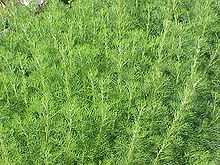Artemisia abrotanum
| Artemisia abrotanum | |
|---|---|
 | |
| Scientific classification | |
| Kingdom: | Plantae |
| (unranked): | Angiosperms |
| (unranked): | Eudicots |
| (unranked): | Asterids |
| Order: | Asterales |
| Family: | Asteraceae |
| Genus: | Artemisia |
| Species: | A. abrotanum |
| Binomial name | |
| Artemisia abrotanum L. | |
| Synonyms[1] | |
| |
Artemisia abrotanum (southernwood, lad's love, southern wormwood) is a flowering plant. Found in Europe, the genus Artemisia was named for the goddess Artemis. Other common names include: old man, boy's love, oldman wormwood, lover's plant, appleringie, garderobe, Our Lord's wood, maid's ruin, garden sagebrush, European sage, sitherwood and lemon plant.
Southernwood has a strong camphor-like odour and was historically used as an air freshener or strewing herb. It forms a small bushy shrub, which is widely cultivated by gardeners. The grey-green leaves are small, narrow and feathery. The small flowers are yellow. It can easily be propagated by cuttings, or by division of the roots.
This plant has gained the Royal Horticultural Society's Award of Garden Merit.[2]
Uses
A yellow dye can be extracted from the branches of the plant, for use with wool. Its dried leaves are used to keep moths away from wardrobes. The volatile oil in the leaves is responsible for the strong, sharp, scent which repels moths and other insects. It was customary to lay sprays of the herb amongst clothes, or hang them in closets, and this is the origin of southernwood's French name, "garderobe" ("clothes-preserver"). Judges carried posies of southernwood and rue to protect themselves from prisoners' contagious diseases, and some church-goers relied on the herb's sharp scent to keep them awake during long sermons.[3]
The pungent, scented leaves and flowers are used in herbal teas. Young shoots were used to flavor pastries and puddings. In Italy, it is used as a culinary herb.
A poem by Edward Thomas (1878 - 1917) concerns the herb: | Old Man or Lad's Love
References
- ↑ "The Plant List: A Working List of all Plant Species".
- ↑ "RHS Plant Selector Artemisia abrotanum AGM / RHS Gardening". Apps.rhs.org.uk. Retrieved 2012-11-07.
- ↑ Alice Morse Earle (1851-1911), The Sabbath in Puritan New England, chapter 4.
External links
| Wikimedia Commons has media related to Southernwood. |
- Southernwood Spice Page by G. Katzer
- IPNI Listing
- Kew Plant List
- USDA Profile